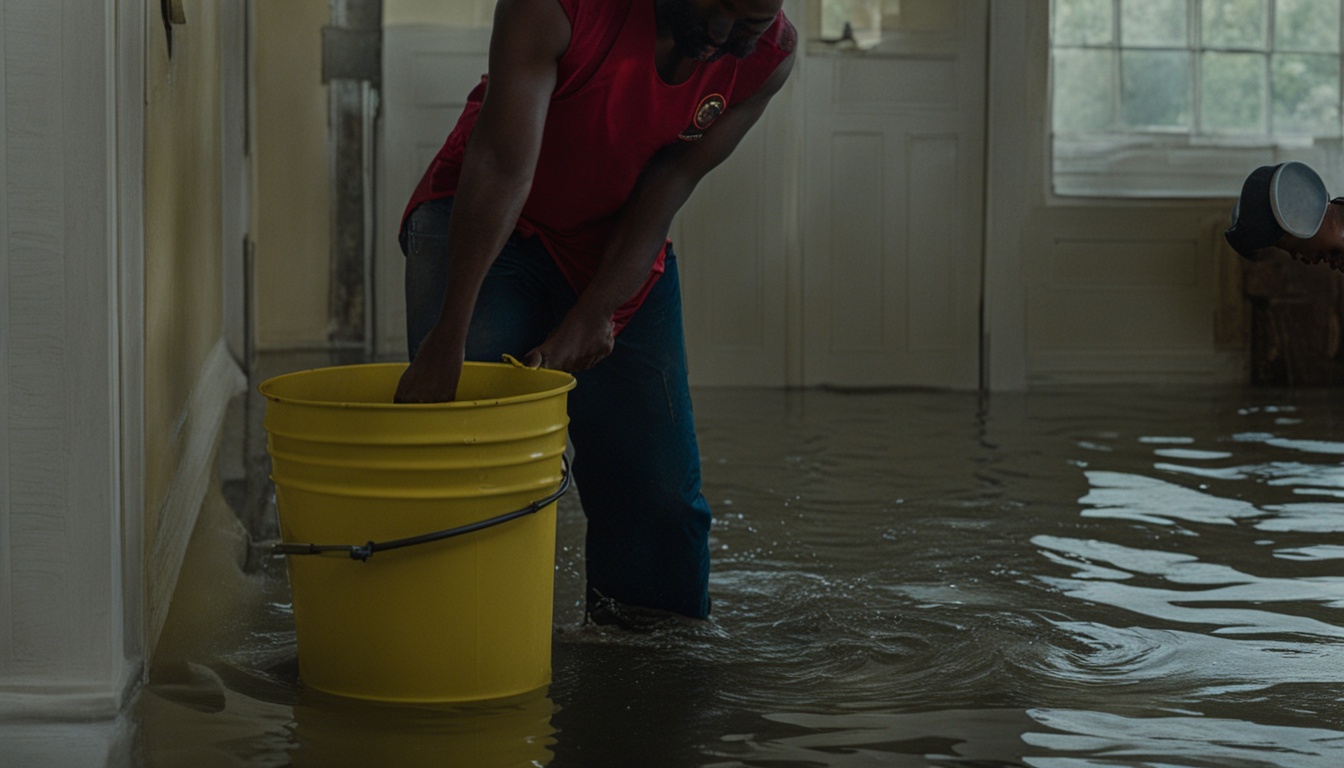Have you ever thought about how mold grows so fast after a home flood?
Flooded homes need quick steps to stop more damage and make water cleanup work well. Standing water right after a flood makes mold likely, and it can start within a day. For safety, always turn off the power before taking out the water.
You can use different methods to get rid of the water, like using a squeegee, mopping, or a wet/dry vacuum. It’s important to take out as much water as you can. Leaving any water means it’s harder to dry your home out. Plus, it raises the risk of mold growing.
Key Takeaways
- Swift action is crucial to limit water damage and mold growth after a flood.
- Ensure power is disconnected before entering a flooded area to avoid electrocution risks.
- Diverse methods, including squeegeeing, mopping, and vacuuming, are effective for water removal.
- Complete moisture removal is necessary to dry out a home after a flood properly.
- Remaining water increases the complexity and duration of the drying process, raising mold growth risks.
Assess the Situation
When dealing with home floods, it’s key to evaluate the situation. The first step is to find where the water is coming from. Knowing if it’s from inside your home, like a burst pipe, or from outside, like heavy rain, tells you how careful you need to be. If it’s inside, you might just need protective clothes for water removal. But if it’s from sewage, getting professionals involved is safer.
Safety is paramount during a home flood. Always turn off the electricity first to prevent electric shock. Next, look at the room layout to plan how to remove water effectively. Working from the center outwards makes water removal faster and more efficient.
Evaluating the flood thoroughly helps homeowners handle the crisis better. It shows the seriousness of the situation and whether experts are needed. Being well-prepared for water removal makes this part of the cleanup safe and successful.
Initial Water Removal Techniques
Dealing with standing water after a flood quickly is key to prevent more harm. Homeowners can use simple methods to remove water. These help in avoiding further damage.
At first, use basic tools like mops, brooms, and a squeegee. These can lower water levels fast. All homeowners can use them, and you don’t need any special gear. A good squeegee moves water out quickly, helping a lot.
For heavy duty water removal, a wet/dry vacuum is your best bet. It’s great for pulling water from floors and rugs. But, it can wear you out because you’re always dumping out the water it sucks up.
It’s very important to start at the room’s center and move out. This way, you make sure you get all the water. Doing things this way, you lessen the risk of mold growing later on.
Using a squeegee and wet vacuum carefully can stop a lot of damage. It also speeds up how fast your home dries. These basic steps are crucial for the rest of the water cleanup.
Extraction and Evaporation
Using tools like vacuums and pumps makes this step quick and efficient. However, drying through evaporation takes more time. If we don’t get all the water out at first, drying it by evaporation becomes harder. This also raises the risk of mold.
For serious water issues, professional help is key. They use strong vacuum tools and pumps to get the water out fast. After that, they dry the structure using advanced methods. Special tools are used to make sure the floors, walls, and furniture don’t stay wet. This full process helps prevent serious damage from the water.
How do I get rid of water in my house?
Removing water effectively in houses built with a pier and beam foundation is crucial. Standing water can cause mold and mildew. This can be a serious health risk and weaken your home’s structure. So, it’s important to prevent water from sitting near your foundation.
There are many ways to improve water drainage. Options include French drains and area drains. Adding moisture barriers can also help keep water out, which protects your foundation. Advanced Foundation Repair in Dallas, Texas, is an expert in these methods. They offer Advanced Pro-Lift Technology to help your home stay safe from water damage for a long time.
It’s vital to keep water from collecting around your foundation. Using methods like French drains helps redirect water. This lowers the chance of water causing problems. Adding moisture barriers acts as even more protection against water seeping in.
In Dallas, Advanced Foundation Repair has the know-how to fix foundation issues. They offer lifetime warranties and flexible payment plans. This makes them a trusted choice to guard your home against water damage.
- French drains for optimal water redirection
- Moisture barriers to prevent water infiltration
- Area drains to manage excess water
- Swales to naturally channel water away from your foundation
Protecting your home from water is key to avoiding costly fixes. Using tools like moisture barriers and drainage systems keeps your house dry and safe. By using these methods, you can prevent significant damage to your foundation.
Professional Help for Water Removal
Contact Water Mold Fire Restoration for good water removal. They are quick to respond in emergencies. Their skilled team stops damage from getting worse.
Then, structural drying companies use special tools to dry your space. This helps stop mold and keep your place safe.
Many experts provide free inspections, making their skills easy to use. With pros on board, you can relax knowing they will manage large water problems well.
Conclusion
Handling water issues quickly is key to recovering from floods and preventing damage. Acting fast helps avoid serious damage to your home and health. From figuring out the flood’s extent to removing water, every step matters a lot.
When you face big water problems or water that’s not clean, getting help is smart. Water Mold Fire Restoration experts quickly remove water to stop mold. Knowing when to get their help means you deal with water issues perfectly.
Using the right tools and knowing when to get help lets homeowners keep their homes dry. This isn’t just about getting rid of water. It also prevents more damage, helping your home stay safe and healthy for a long time.









